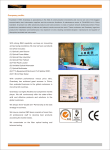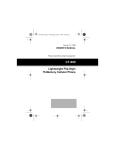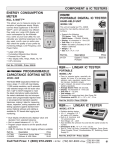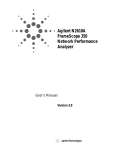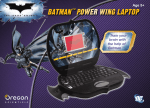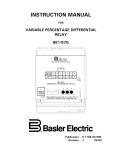Download Triplett Fox 2 & Hound 3 Probe Kit
Transcript
TRIPLETT Fox & Hound 3 The Instruction Manual 1 Fox and Hound 3 Instruction Manual Table of Contents 1. Introduction . . . . . . . . . . . . . . . . . . . . . . . . . . . . . 2 - 3 2. FOX Features . . . . . . . . . . . . . . . . . . . . . . . . . . . . . . . 3 3. HOUND 3 Features . . . . . . . . . . . . . . . . . . . . . . . . . . . 4 4. Safety Warnings and Cautions . . . . . . . . . . . . . . . . 5 - 6 5. Specifications . . . . . . . . . . . . . . . . . . . . . . . . . . . . 7 - 10 6. Control Locations . . . . . . . . . . . . . . . . . . . . . . . . . 11 - 12 7. Getting Started . . . . . . . . . . . . . . . . . . . . . . . . . . . 13 - 20 8. Operating Instructions: Detailed Information . . . 20- 49 9. Accessories and Replacement Parts . . . . . . . . . . . . . . . 49 10. Warranty . . . . . . . . . . . . . . . . . . . . . . . . . . . . 50 & 51 1: Introduction The FOX and HOUND 3 wire tracing kit consists of a classic FOX Tone Generator (Toner) and a newly designed HOUND 3 Inductive Amplifier (Probe). The FOX is a battery operated handheld lightweight multi-function Toner that can generate 3 different tones (Hi, Lo, and Warble), perform some basic telephone line tests (loop mA and line polarity), and provides a visual continuity test. The HOUND 3 is a battery operated handheld lightweight Probe, with a thumbwheel Sensitivity control and Signal Strength indicator LED. It improves on previous designs (the HOUND and HOUND 2) with builtin LED illuminators, a bandpass filter, an earphone jack, and an easy access battery cover. An included convenient carrying case (with belt loop attachment) provides ease of use and protective storage for the FOX and HOUND 3. 84-863 2 When used together, the FOX and HOUND 3 aids in identifying, locating, and tracing wires, cables, and other conductors. When the FOX is used to apply a “tone” to a wire, the HOUND 3 can usually locate the wire inside of, or behind electrically non-conductive surfaces (plastic, wood, drywall, etc), up to 12 inches away. The HOUND 3 does not have to contact a wire to identify it . . . i.e. no stripping needed. FOXs and HOUNDs have been used in the telephone, electrical, security, sound reinforcement, video, automotive, and boating industries, to name a few. 2: Key Features of the FOX • • • • • Generates 3 distinct tones usable for wire tracing Performs a variety of tests on telephone lines Line powered in Tone Mode LED Indicator for continuity Supplies “Talk Power” to allow communicating between handsets (talksets) or powering a telephone • Alligator clips and modular plug allow for connection to stripped wires, terminal panels, or a standard modular jack (single line) • Powered by a standard 9V battery (not included) • One Year Warranty 3 3: Key Features of the HOUND 3 • New Headlights to help light your way in dark areas and reduce florescent light noise! • Streamlined Design allows for better access in hard-to-reach areas • New Shielded Design to suppress “Feedback Squeal” • Bandpass Filter to suppress 60Hz and Hi Frequency Noise • Earphone Jack for use in quiet or noisy environments. • Improved Sensitivity and Loudness • Includes New Conductive Plastic Duck-Bill Tip for Safer, Easier Penetration in cable bundles Metal tip also included • Easy Access Battery Door • Adjustable volume / sensitivity control • LED gets brighter as the signal gets stronger - LED indication even works when Earphones are used! • Contains a hi-gain, hi-impedance amplifier • Capable of identifying the Fox’s tone up to 12 inches away • Rugged, moisture resistant, mylar cone speaker • Powered by a standard 9V battery (not included) • One Year Warranty 4 4: Safety Warnings and Cautions 4.1 Do not connect FOX or HOUND 3 to any source of AC power. AC voltages above 30 volts can be dangerous, and may result in user injury. The FOX and HOUND 3 is not intended to trace live AC power lines. The FOX will be damaged if connected to a live AC power line. 4.2 Use care when using the HOUND 3 to probe any wire or cable. An unexpected dangerous voltage may be present, which may result in injury to the user. 4.3 Potentials applied to the HOUND 3’s probe may appear, greatly reduced, at the earphone jack. This could pose a shock hazard to the user, if for example, the probe is brought in contact with a high voltage potential. 4.4 The HOUND 3’s metal probe can accidentally short out a circuit that is being tested. Use care when testing live circuitry, or an accidental short may result in equipment damage or user injury. 5 4.5 Use caution when working with telephone lines. They can support dangerous voltages. 50VDC is often present, and 100VAC may be present during ringing. Additionally, telephone lines may support dangerous levels of common mode voltages. In some circumstances, user injury may result. 4.6 Use caution when working with any long unconnected wire or cable. Under some conditions, unconnected wires may “float up” to dangerous potentials, and touching them may result in user injury. 4.7 Use care when connecting the FOX to any wire or cable. An unexpected dangerous voltage may be present, which may result in injury to the user. 4.8 Potentials applied to any connection of the FOX may appear on other FOX connections. For example, a potential applied to the RJ-11 plug may appear on the alligator clips. This could pose a shock hazard to the user, if for example, a telephone cable with 120VAC on it is connected to the FOX . The 120VAC may appear on the alligator clips, and shock the user. 6 5: Specifications 5.1: FOX Specifications 5.1.1: Telephone Loop mA and Line Polarity Test: Indication: Red LED lights to indicate presence of Loop mA in correct polarity Load: Approx. 13mA at 50VDC (usually less than off-hook recognition current) 5.1.2: Visual Ring Indication: Indication: Red LED flashes to indicate ringing 5.1.3: Tracer Tone (with fresh battery): Waveform: Square Wave or Differentiated Square Wave Level: Approx. 8Vpp (+14dBu, 600 Ohm) into an open circuit (un-terminated cable or telephone line) Approx. 5Vpp (differentiated) +2dBm into a 600 Ohm load (terminated telephone line) Frequencies (3 types): LO - approx. 800Hz HI - approx 1000Hz WARBLE - alternates between LO and HI 5.1.4: Connections: RJ-11 Plug for connection to telephone lines Color Coded Alligator Clips for connection to stripped wires or terminals 7 5.1.5: Visual Continuity: LED lights when continuity is established Open Circuit Voltage: 10v max. Test Current: 35mA max 5.1.6: Talk Power: Open Circuit Voltage: 10v max. Current (Short Circuit): 35mA max Current with 1K Loop: Typically 6mA with new 9v battery 5.1.7: Protection: Will withstand 56V with 400 Ohms series resistance applied across outputs. Will withstand 175V peak with 100 Ohms series resistance, superimposed on 56V, for 100mS (standard telco “ring” signal). DO NOT CONNECT TO LIVE AC POWER LINES. 5.1.8: Power: Battery: Standard 9v Alkaline Battery (NEDA 1604A, Eveready 522) Battery Life: Approx 500 hours continuous in Tone Generator mode Telephone Line Powered Operation: Tone Generator operates without 9v battery installed. Operates from standard telephone line (46 to 53v, 400 to 1800 Ohms) in normal or reverse polarity. 8 5.1.9: NiCad Charging Current: Approx. 9mA 5.1.10: Dimensions: Case: 3.7"H x 2.4"W x 1.1"T (93mm x 61mm x 28mm) Leads: Alligator Clips: Typically 11 inches long RJ-11: Typically 9 inches long 5.1.11: Weight: Less than 7 ounces including battery 5.2: HOUND 3 Specifications 5.2.1: Amplifier High impedance bootstrapped FET input for high gain and sensitivity. Incorporates a bandpass filter to improve sensitivity to FOX signals while suppressing 60Hz. 5.2.2: Sensitivity Detects FOX’s tone up to 12 inches away. 5.2.3: Speaker 1-1/2" mylar coned speaker with high strength alnico magnet is rugged and moisture resistant. 5.2.4: Probes (2 provided) a) Solid aluminum conical probe for low resistance contact testing b) Conductive Plastic duckbill probe with metal threads for sensitive non-shorting testing. 9 5.2.5: Earphone Jack Accepts standard 1/8" (3.5mm) mini phone plug, either mono or stereo. For use with electromagnetic (dynamic) earphones from 8 Ohms to 2000 Ohms. Automatically mutes loudspeaker when earphone is used. An earphone with a shielded cable is suggested to reduce the possibility of feedback from the cable to the probe tip. 5.2.6: Signal Strength Indicator Bright red LED signal strength indicator maintains sensitivity, even when the earphone is used. 5.2.7: Power A standard 9 volt alkaline battery (NEDA 1604A, Eveready 522) provides power for all circuitry. The battery is accessible by removing a convenient snap-on door (no tools required). The HOUND 3 is protected against the accidental reversal of the battery polarity. 5.2.8: Illumination 2 efficient bright white LEDs powered from separate current sources provide constant illumination until battery is mostly depleted (about 6 volts). 5.2.9: Size 1-7/8" dia at speaker, 1-3/8" dia at body, 8-1/4" long with metal probe, 9-1/4" with conductive plastic probe. 5.2.10: Weight Less than 8 ounces including battery 10 6: Fox and Hound 3 Control Locations (See Figures 1 and 2) A TRIPLETT CONTINUITY TALK B TONE HI WARBLE LO C OFF / LINE POLARITY A LED D B Function Switch C Tone Switch D Modular Plug E E Alligator Clips Figure 1 FOX Control Locations 11 AA Conductive Plastic Duckbill Tip BB Metal Conical Tip BB AA CC CC LED Lights DD Signal Strength Indicator EE Power Button FF Sensitivity Control GG Earphone Jack FF DD HH II GG JJ EE HH Battery Connector Battery Strap JJ Battery Cover KK Battery (not included) LL Speaker Cover LL Figure 2 Hound 3 Control Locations 12 KK II 7: Getting Started 7.1: The FOX 7.1.2: Installing a standard 9 volt battery in the FOX Remove the screw on the back of the case. Remove the case front. Install / replace the battery. Reassemble the case. 7.1.3: Using a rechargeable battery in the FOX The FOX can recharge a 9 volt Nicad battery by using telephone Loop Current (CO power). To use this feature, simply replace the standard 9 volt battery with a 9 volt Nicad battery. To charge the Nicad, set the FOX to OFF/LINE POLARITY, and connect the alligator clips to the line in Reversed Polarity (Red to positive and Green to negative). Connecting to the line in Normal Polarity WILL NOT CHARGE the battery. Approximately 16 hours is required to fully charge a typical Nicad battery (refer to battery manufacturer specs). Emergency Fast Charge: The FOX’s circuitry incorporates a fast charge mode. This mode is not recommended for casual use because it exceeds the battery’s nominal charge current and will shorten the battery’s life. Charging current could be as high as 90 mA. To use this feature, set the FOX to CONTINUITY / TALK and connect the alligator clips to a powered line in Reversed Polarity (Red to positive and Green to negative). DO NOT charge the battery for more than 30 minutes. Irreversible 13 shortening of the battery’s life may result. DO NOT connect to the line in Normal Polarity. Damage to the battery may result. 7.1.4: Testing the Battery in the FOX After installing the battery, a basic test can be performed to verify that the battery is powering the FOX. Set Function Switch (B) to its CONTINUITY / TALK position. Whiles observing LED (A), short alligator clips (E) together. If the battery is OK, the LED will light. A bright LED indicates a fresh battery . . . a dim LED indicates a weak battery . . . no light from the LED indicates a dead battery. Helpful Hint: Although a weak battery in the FOX may not provide adequate power to operate several talksets, the TONE feature often works with a weak battery, and the POLARITY test does not require a battery to work. 7.2: The HOUND 3 7.2.1: Installing a 9 volt battery in the HOUND 3 Remove Battery Cover (JJ) by pressing the release tab towards probe end of the case. Remove Battery Connector (HH) and Battery Strap (II). Snap Connector to 9 volt battery and slide Strap over battery. Position Strap so that the finger tab is on the side of the battery. Insert battery into HOUND 3 case, placing bottom of battery against foam, and compressing the foam while completing the battery insertion. Lead wires should be behind battery and “dressed” to allow bat14 tery to be fully inserted. The finger tab on the Strap should be sticking out of the Battery Compartment. This tab is used to remove the battery. Fold the tab over, and secure the Battery Cover to the case by inserting the end near the Earphone Jack (GG) first, and snapping the opposite end of the Cover to the case. 7.2.2: Testing the battery in the HOUND 3 The battery in the HOUND 3 will not last as long as the battery in the FOX. The LED Lights (CC) can be used as a rough indication of battery charge. With a fresh battery, the Lights will be bright, and the HOUND 3’s Speaker (LL) will produce a loud, strong, signal from the FOX. As the battery is drained, the signal from the FOX will not sound as loud in the HOUND 3’s Speaker. When the Lights begin to dim, the battery should be replaced. 7.3: A Few Basic Tests Turn on the FOX by sliding the Function Switch to the TONE position. Set Tone Switch (C) to the WARBLE position. This is the position that most users prefer for wire location and tracing. Rotate the HOUND’s Sensitivity Control (FF) to its mid-position. Turn on HOUND 3 by pressing and holding the Power Button (EE). Bring the HOUND 3’s probe (AA or BB) near the FOX’s alligator clips. The warbling signal from the FOX should be heard in the HOUND 3’s Speaker (LL). Adjust the Sensitivity Control for the desired loudness. Move the probe of the HOUND 3 closer to and farther away from the FOX’s alli15 gator clips. Notice how the loudness of the warble sound increases, and how the brightness of the Signal Strength Indicator (DD) increases as the probe approaches the alligator clips. In general, the HOUND 3 is used by bringing it into proximity with the wire/cable that the FOX is connected to, listening for the TONE signal from the FOX, and moving the HOUND 3 in such a manner as to increase the loudness of the TONE signal from the HOUND 3’s speaker . . . i.e. searching for the loudest TONE signal. The HOUND 3’s Sensitivity Control is usually set to maximum when tracing wires through walls and ceilings, and is set to a lower setting when in close proximity to the signal carrying wires. In situations where there is a lot of acoustic noise, observing the brightness of the LED, or using earphones, may prove more useful than attempting to hear the signal from the speaker. Helpful Hints: It is normal to hear a humming or buzzing noise coming from the HOUND 3’s speaker when it is in an area with fluorescent lights, neon signs, transformers, etc. In fact, an easy test to verify the HOUND’s is working is to move it toward an operating fluorescent light and note that the buzzing sound gets louder, and the brightness of the LED increases. If the buzzing sounds from fluorescent lights interfere with tracing/locating wires, the user may consider turning the fluo16 rescent lights off and using the HOUND 3’s built in lights (which do not produce any noise). 7.4: Choosing a Probe Tip The HOUND 3 is supplied with 2 Probe Tips. The metal conical tip provides the strongest signal in most cases, because it can make a metallic electrical connection with a wire carrying the FOX signal. In some cases, the metal tip can be a safety hazard . . . because it might short out a live circuit that the user is “probing”. The metal tip is rather short and large in diameter, making it difficult to insert into wire bundles while searching for the target wire. The conductive plastic duckbill tip will not short out most electrical circuits. The conductivity of the probe is very low compared to the metal tip. Additionally, the slender duckbill shape allows the tip to be inserted into wire bundles while searching for the target wire. Most users prefer this tip, although it is not quite a rugged as the solid metal tip. 7.5: Earphone Jack The HOUND 3 has a Jack (GG) for connecting external Earphones (Headphones). When using the external earphones, the HOUND’s internal speaker is turned off. The earphones are usually used when there is so much ambient noise that the speaker cannot be heard, or when the sound of the speaker may be annoying to others in the vicinity. 17 Helpful Hint: Almost any type of earphones whose plug will fit into the Earphone Jack will work. Some types will work better than others. An earphone with shielded wires is recommended. Use of earphones with unshielded wires may cause a squealing sound to be heard. 7.6: How it works The HOUND 3 works by capacitively sensing the electrostatic field radiated by wires carrying a signal from the FOX. The greater the radiated field, the better the HOUND 3’s ability to locate a wire. Anything that reduces the intensity of the field will impair the HOUND 3’s effectiveness in locating a wire. In general, several things affect field intensity . . . shielding, signal (tone) amplitude on the wire, and wire dress. In instances where a system is shielded (shielded wires, metal junction boxes, metal conduit, etc.), the effectiveness of the HOUND 3 is impaired. In multi-wire cables, grounded wires, or wires connected to low impedance circuits, adjacent to the target wire can act as shields, reducing the HOUND 3’s ability to sense properly. Spreading the wires apart will reduce the shielding effect and allow the HOUND 3 to work better. Defects in a cable or wires, such as shorts or opens, will reduce the signal amplitude and hence the HOUND 3’s ability to locate the target wire. Terminating a wire or line in a low impedance also reduces signal amplitude and the HOUND 3’s locating ability. It is also possible for wire position to cause nullification of the field. 18 If the target wire is connected to other wires and circuits, for example, to switches, lights, relays, transformers, etc., the FOX TONE will pass through these devices and out onto other wires connected to these devices . . . making tracing of the target wire very difficult, if not impossible. In general, the FOX and HOUND 3 cannot be use to trace wires buried underground or in concrete. This is because the moisture content of the earth or of concrete allows the surface to be electrically conductive, causing it to act as a shield around the buried wire. Wet drywall, wet cinder block walls, or any wet wall surface will also shield the FOX signal, preventing the HOUND 3 from detecting its presence. The actual wire being wet can shield the signal. The wire can be wet internally, shielding the signal. This phenomena has been observed in “Romex” electrical wire. The internal paper separator can get wet from exposure to the weather. The exterior surface of the Romex can be dry, but because the internal paper separator is wet, it shields the tracer signal. Extremely high humidity will damp (collapse) the electrostatic field, reducing the effectiveness of the HOUND 3 in finding the FOX signal. Condensing atmospheres may even cause the products to malfunction until they dry out. The HOUND 3 will not trace wires through a metal conduit. It can, however, identify the wires after they exit from the conduit. 19 General Rules for Effective Tracing: …. Do what works best. Try both LINE/GROUND and LINE/LINE tracing (see following text). …. Separate wires when possible. …. Move wires away from shielding when possible. …. Un-terminate wire if necessary. …. Turn off noise sources to reduce buzzing OPERATING INSTRUCTIONS: 8: Detailed Product Information 8.1: FOX Details (Refer to Figure 1) The Function Switch (B) sets the basic operating mode. The 3 positions each have several testing functions associated with them. The follow text describes these test features in detail. The Tone Switch (C) selects a HI, LO, or WARBLE tone. The alligator clips (E) and the modular plug (D) allow the FOX to be connected to a variety of different wires and cables. The LED (A) provides indication of line polarity and continuity. 8.1.1: Telephone Loop Current Powering: Line Powering On telephone lines, the FOX’s TONE mode can be powered from “Loop Current”. Loop Current is provided by the Telephone Company (the Central Office…. CO) to power the typical telephone. When powered by Loop Current, the FOX’s internal 9 volt battery is not needed. To use this feature, simply connect the FOX’s alligator clips (E) or modular plug (D) to the powered line on which the tone is to be sent. The FOX will not “seize” or “capture” the line of most phone systems. 20 Helpful Hint: Although the FOX does not require a battery when generating a tone when Loop Current is present, if a battery is in the FOX, it will be used as part of the FOX’s power source. Due to the FOX’s internal circuitry, less battery power is used if the FOX is connected to the line in Reverse Polarity, i.e. Tip to Negative, Ring to Positive. Therefore, for greatest battery life, connect to a powered line in Reverse Polarity. 8.1.2: OFF / LINE POLARITY: Telephone Loop Current and Line Polarity Testing: “Loop Current” is provided by the Telephone Company (the Central Office…. CO) to power the typical telephone. Without Loop Current, a telephone won’t work. The FOX can test a telephone line for the presence of Loop Current, and test for its proper polarity. In telephone circuits, the green and red wires are identified as Tip and Ring respectively. Remember, Ring is red. In telephone circuitry, the red wire is negative polarity, not positive. (Note: The Ring just mention has nothing to do with a phone ringing.) . The FOX’s modular plug is wired in the standard polarity used in the telephone industry. The alligator clips are also polarized, with the Red clip being the Ring and the Green clip being the Tip connection. Referring to Figure 1, set the Function Switch (B) to its OFF/ LINE POLARITY position. Plug the Modular Plug (D) into 21 the modular jack to be tested, or connect the Alligator Clips (E) to the line to be tested (Do not use the Modular Plug and the Alligator Clips simultaneously). If Loop mA is present, and in the correct polarity, the FOX’s CONTINUITY/TALK LED (A) will light. If the polarity is incorrect, or Loop mA is not present, the LED will not light. Helpful Hints: If using the Alligator Clips, and the LED does not light, try reversing the positions of the clips. If the LED then lights, Loop mA is present, and in the polarity indicated by the clips. Although the LED will light on a BUSY (off-hook) line when performing the test, the LED will light much more brightly if the line is CLEAR (on-hook). The FOX also indicates line polarity, when the line is CLEAR, in the TONE Mode. However, the line polarity LED may or may not light in the TONE Mode, on a BUSY line. On analog phone lines, reversed polarity seldom causes a problem. Many modular cords and couplers reverse the polarity of the phone line passing through them. 8.1.2.1: Ringing Current: The FOX will signal the presence of ringing current by flashing its LED. This indication is obtainable in either the OFF/ LINE POLARITY or TONE mode. Depending on the phone system, the LED may indicate ringing current in either Normal or Reversed Polarity. To perform this test, simply con22 nect the alligator clips or the modular plug to the line to be tested. The FOX will not seize the line on most phone systems. 8.1.3: CONTINUITY / TALK When the Function Switch is set to the CONTINUITY / TALK position, the FOX can perform basic Continuity tests, or supply Talk Power to several “talksets”. 8.1.3.1: Continuity Testing: The FOX can be used as a visual continuity indicator. Set the FOX’s Function Switch to CONTINUITY / TALK. When the FOX’s red and green alligator clips are touched together, the LED will light, indicating continuity. To check continuity, connect the red and green alligator clips to the circuit under test and observe the LED. Continuity from zero to 10K ohms will be indicated by the brightness of the LED. The LED will be bright at low resistances and dim at high resistances. Do not attempt to measure continuity on a powered line. 8.1.3.2: Talk Power: The FOX will supply power to operate handsets. This feature is particularly useful when two installers are working at terminal panels that have at least one identified pair connected between them, but are not yet connected to the CO battery. The FOX allows the installers to communicate using their handsets. Set the FOX’s Function Switch to Continuity / TALK and connect the handsets as shown in Figure 3. The FOX’s LED will light when supplying Talk Power. 23 NOTE: Some handsets may not operate properly at the power level supplied by the FOX. TALK SET TALK SET WIRE PAIR TRIPLETT CONTINUITY TALK TONE HI WARBLE LO OFF / LINE POLARITY Figure 3 FOX supplying “Talk Power” 24 8.1.4: TONE: Wire Tracing, Identification, & Open Faults The uses of the FOX Tone mode can usually be divided into three categories . . . tracing, identification, and locating open faults. 8.1.4.1: General Wire Tracing Information: The FOX and HOUND 3 will not trace “live” AC or DC power wires. The only type of “live” circuit that the FOX and HOUND 3 will trace is a telephone circuit. The FOX’s tracer tone will not penetrate electrically conductive materials . . . like any kind of metal or wet earth. This means that the HOUND 3 cannot pickup the tone if the target wire is in a metal conduit or is underground. The HOUND 3 will pickup the tone at locations where the target wire emerges from the conduit or the earth. The FOX’s tracer tone will penetrate wood frame walls and ceilings, and plaster and drywall. Under good conditions, a HOUND 3 can pickup the tone from a foot or more away from the target wire. The FOX’s tracer tone will pass through any electrical circuitry connected to the target wire(s). Hence, to identify a specific wire, it will be necessary to disconnect all loads and circuitry from the wire. This includes switches, capacitors, resistors, coils, transformers, lights, motors, etc. 25 The FOX’s tracer tone can be shorted out by any loads on the target wire. All loads must be disconnected from the target wire. Crosstalk may occur in multiwire cables, in wires bundled together into a harness, or in wires that run parallel to each other for long distances . . . making identification of the target pair difficult. Crosstalk is the bleeding of the tracer tone from the target wire onto adjacent wires. A tracer tone applied to a target wire or wires may crosstalk onto adjacent wires. Some wires/ cables are constructed to reduce the crosstalk, but other wire/ cables crosstalk readily. So much crosstalk can occur that the tracer tone on the adjacent wires can be almost as large as the original tone on the target wire. This can make it difficult to identify the target wire with the HOUND 3. A method of trying to determine if the tone being received is the original tone, or is crosstalk, is to short out the wires with the tone at the location where the HOUND 3 is being used. The FOX supports the Remote Tone Kill method. Shorting the output of the FOX, anywhere along the length of the target wire, kills the tone everywhere along the wire. If shorting the wires only reduces the tone’s level, but does not completely kill it, then the shorted wires have crosstalk on them, and are not the target wires. If shorting the wires completely kills the tone, then its likely that the wires are the target wires. Unfortunately, this test is not 100% effective. 26 8.1.4.2: Wire Tracing Methods: There are two basic wire tracing methods . . . “floating” and “grounded”. In the floating method (also called Line to Line), the tracer tone is applied to two wires (a pair) in the cable or wire harness to be tested. See Figure 4. The FOX’s red clip is connected to one wire and the green clip is connected to the other wire. This method is often used on telephone, intercom, or alarm wires. The floating method tends to cancel out some of the tracer tone, so a HOUND 3 usually works best when the user has access to the wires, and can place the HOUND 3 right against the wires. This method identifies the wires as a pair. It will not identify which wire is connected to the FOX’s green clip or which wire is connected to the red clip. 27 MULTI-WIRE CABLE TERMINALS TARGET WIRES TRIPLETT CONTINUITY TALK TONE HI WARBLE LO OFF / LINE POLARITY Figure 4 Floating or Line-to-Line Tracing 28 In the grounded method (also called Line to Ground), one clip of the FOX (either the red or green) is connected to earth ground or a “fake ground”, and the other clip is connected to the target wire. The target wire can be one wire of a pair or a multiwire cable. See Figure 5. This method creates the strongest tracer tone, and is often used when wires are traced through walls or ceiling. It is also useful for identifying a specific wire within a bundle of wires. If connection to a true ground is not available, a large metal object can be used as a fake ground. For example, a large metal desk or a metal file cabinet can be used. When tracing wires in a car, trailer, or RV, etc. the metal frame or body can be used as a ground. When tracing wires in a boat (that is in the water) with a wood or fiberglass glass hull, any piece of metal that comes in contact with the water can be used as a ground. Simply connect one clip of the FOX to the ground or fake ground, and the other clip to the target wire. 29 MULTI-WIRE CABLE TERMINALS TARGET WIRE TRIPLETT CONTINUITY TALK TONE HI WARBLE LO OFF / LINE POLARITY Figure 5 Grounded or Line-to-Ground Tracing 30 Helpful Hints: Extension pieces of wire, or long clip leads, can be used to connect the FOX to a ground or fake ground. The extension wire can be hundreds of feet long if necessary. To test a fake ground to see if it can be used for wire tracing, connect one clip from the FOX to the candidate object (like a metal desk) and the other clip of the FOX to the target wire. Hold a HOUND 3 near the object. A “good” fake ground will not radiate much tracer tone. The tracer tone should be much stronger on the FOX’s other clip. If it is not, the target wire may be shorted to ground, or the fake ground may not be adequate. Generally, the larger the object used as the fake ground, the better it works. If the target wire is somehow connected to ground, this will greatly reduce or kill the tracer tone. 8.1.4.3: Telephone wires: The floating method is usually used to locate a pair of wires in a telephone junction block. If the wires are already terminated into a modular telephone jack, simply plug the FOX into the jack. This method works with the phone line connected or disconnected from the wires going to the telephone company. A stronger trace is usually obtained if the wires are not connected to the telephone company. If the wires are not connected to the telephone company, the grounded method can be used to trace telephone wires through a wall or ceiling. Use the green and red clips to con31 nect to the phone line and ground. To identify the wires, if using the floating method, momentarily short the suspected wires together while listening to the FOX signal with the HOUND 3. If the FOX signal is completely killed (not heard on the HOUND 3), the selected pair is probably the target pair. If the signal is not completely killed, the wrong pair has been selected, or there is an open fault in the pair, and crosstalk is being picked up from the other wires. To identify the wires, if using the grounded method, momentarily short the suspected wire to ground while listening to the FOX signal with the HOUND 3. If the FOX signal is completely killed (no heard any more on the HOUND 3), the selected wire is probably the target wire. If the signal is not completely killed, the wrong wire has been selected, or there is an open fault in the wire, and crosstalk is being picked up from the other wires. (This will not work if a fake ground is being used. An actual ground is required to perform this test). An “Open Fault” may involve either one or both wires of a telephone wire pair. Finding the open will only work if there are no other faults (like a short to earth ground) in the pair. If the pair is “live”, disconnect the pair from the incoming telephone line before trying to locate the open. Short the wires together at the far end and connect the shorted wires to a good earth ground (a fake ground may not work well). 32 At the other end of the wires, connect one of the clips of the FOX to a good earth ground. Experimentally connect the other clip of the FOX to one wire and then the other, while listening to the tracer tone on this clip with a HOUND 3. If the level of the tracer tone drops significantly when the clip is connected to one of the wires, this wire is probably OK and the other wire is open. That is, the open wire is the one that doesn’t drop the level of the tracer tone. If neither wire drops the level of the tracer tone, they are probably both open (or a good ground has not been used). Leave the clip connected to the wire or wires that do not “load down” the tracer tone. See Figure 6. Using a HOUND 3, follow the path of the wires by finding the strongest signal. An abrupt drop in the tracer tone level will occur at the point of the open. Keep in mind, however, if tracing unseen wires in the wall or ceiling, that the wires may pass behind a metal object (like a furnace duct) that prevents the HOUND 3 from picking up the tracer signal, or the wires may diverge from the path of the receiver. Before assuming that the open has been located, try finding the signal nearby or in an adjacent attached wall or ceiling. Also keep in mind that it may not be possible to find the open in all situations, because of the number of variables involved. Helpful Hints: If attempting to trace a telephone wire terminated in a modular jack, but not connected to the telephone company, through a wall or ceiling, insert the FOX’s modular plug into the jack, and then connect either the red or green clip lead to a ground 33 or fake ground. This will boost the tracer tone, and may provide an adequate trace. The strongest trace will be obtained when using the grounded method and the clips (as described above), but if the hint works, the user won’t have to open the modular jack housing to gain access to the wires. STRONG TONE OPEN FAULT WEAK TONE TRIPLETT CONTINUITY TALK TONE HI WARBLE LO OFF / LINE POLARITY Figure 6 Locating an Open 8.1.4.4: Coaxial Cable: Coaxial cable, like that used for cable TV, satellite TV, closed circuit TV, early LAN systems, etc. is often connected to other cables through splitters, combiners, or amplifiers. In order to trace the cable, it must be disconnected from these “loads”. Since coaxial cable is self-shielding, the floating method usually does not work well when tracing the cable. 34 It can be done, but the HOUND 3 must be held very close to the end of the cable to pick up any signal. To apply a floating signal to a coax, connect one clip of the FOX to the center conductor of the coax, and the other clip to the shield of the coax. The grounded method often works better for tracing coaxial cables. Connect one clip of the FOX to a ground or fake ground, and the other clip to the shield of the coax. This method will cause the coax to radiate enough tracer tone to trace the coax thru drywall. To identify the coax, if using the floating method, momentarily short the shield and center conductor together while listening to the FOX signal with the HOUND 3. If the FOX signal is completely killed (not heard on the HOUND 3), the selected coax is probably the target coax. If the signal is not completely killed, the wrong coax has been selected, or there is an open fault in the coax, and crosstalk is being picked up from the other wires. To identify the coax, if using the grounded method, momentarily short the shield to ground while listening to the FOX signal with the HOUND 3. If the FOX signal is completely killed (not heard on the HOUND 3), the selected coax is probably the target coax. If the signal is not completely killed, the wrong coax has been selected, or there is an open fault in the coax, and crosstalk is being picked up from the other coaxes. (This will not work if a fake ground is being used. An actual ground is required to perform this test). 35 It is not unusual for the loose turn-able part of a coaxial connector to have poor electrical contact to the cable shield until it is screwed on to its mating connector. Consider this when making connection to a coax. Because of the way that coax is constructed, it is not possible to find an open in the center conductor. It is possible to find an open in the shield, if the shield is not shorted to the center conductor or ground. Connect the center conductor of the coax to earth ground. Connect the shield and center conductor at the far end of the coax to earth ground. Connect one clip of the FOX to an earth ground. Experimentally connect the other clip of the FOX to the shield of the coax, while listening to the tracer tone on this clip with a HOUND 3. If the level of the tracer tone drops significantly when the clip is connected to the shield, the shield is probably grounded and can’t be traced to the open. If the level of the tracer tone doesn’t drop much, leave the clip connected to shield. Using a HOUND 3, follow the path of the coax by finding the strongest signal. An abrupt drop in the tracer tone level will occur at the point of the open. Keep in mind, however, if tracing unseen coaxes in the wall or ceiling, that the coaxes may pass behind a metal object (like a furnace duct) that prevents the HOUND 3 from picking up the tracer signal, or the coaxes may diverge from the path of the receiver. Before assuming that the open has been located, try finding the signal nearby or in an adjacent attached wall or ceiling. Also keep in mind that it may not be possible to find the open in all situations, because of the number variables involved. 36 8.1.4.5: Power Wires: The FOX and HOUND 3 cannot trace or identify “live” power wires. To use a FOX and HOUND 3 to trace a power wire, power must be removed from the wire, and all loads must be removed from the wire. This may be as simple as turning the circuit breaker off, and turning off all of the loads. NM-B (Non-Metallic wires, sometimes called “Romex”) can be traced by putting one clip of the FOX on the ground or neutral, and the other clip on the hot wire. Trace the wires using a HOUND 3 in the usual manner. If the target wires are in a metal conduit, they cannot be traced until they emerge from the conduit. To identify the wires, if using the floating method, momentarily short the suspected wires together while listening to the FOX signal with the HOUND 3. Warning, take care not to short together live wires! If the FOX signal is completely killed (not heard on the HOUND 3), the selected wires are probably the target pair. If the signal is not completely killed, the wrong wires have been selected, or there is an open fault in the wires, and crosstalk is being picked up from the other wires. To identify the wires, if using the grounded method, momentarily short the suspected wire to ground while listening to the FOX signal with the HOUND 3. Warning, take care not to short together live wires! If the FOX signal is completely killed (not heard on the HOUND 3), the selected wire is prob37 ably the target wire. If the signal is not completely killed, the wrong wire has been selected, or there is an open fault in the wire, and crosstalk is being picked up from the other wires. (This will not work if a fake ground is being used. An actual ground is required to perform this test). 8.1.4.6: Resistance Heating Wires: The FOX and a HOUND 3 can be used to trace the path of a resistance heating wire in a plaster wall or ceiling. This is usually performed to find an open in the wire. It is best if the user is familiar with resistance heating techniques, particularly in regard to the typical patterns used for the wire path. The wire is usually in a serpentine pattern, with the wire spacing and orientation varying depending on the amount of heat needed in different areas of the room. Finding the open can be a challenge. Several techniques can be, and should be, used. It helps if the user performs a few experiments before trying to find the open. See Figure 7. Attach a few pieces of wire (any kind) more than several feet long to each clip of the FOX. Lay the wires out on a non-conducting surface (a wood floor with no metal in the vicinity..... nails are OK, but make sure there’s no metal furnace duct below the floor) parallel to each other, about 4 “ apart. Using a HOUND 3, trace along one of the wires, in normal fashion, noting how the tracer tone becomes stronger as the wire is approached. Now trace along the other wire, noting that it behaves just like the previous wire. Now, slowing move the HOUND 3 from one wire 38 to the other wire. Notice that at approximately the midpoint between the wires, the tracer tone becomes very weak. This is the “null point” . . . the place where the signal from one wire cancels the signal from the other wire. Notice how this null differs from simple loss of signal . . . that is, there’s a very narrow zone where the null occurs, and the signal gets stronger quite rapidly on either side of the null. By waving the HOUND 3 back and forth while slowly moving along the length of the wire, the path of the null point can be followed between the wires. These wires can be thought of as being on either side of the open fault . . . so by using this technique, it will be possible to localize the area in which the fault occurs. STRONG SIGNAL TRIPLETT NULL CONTINUITY TALK TONE HI WARBLE LO OFF / LINE POLARITY SIGNAL FADES Figure 7 39 Reposition the test wires so that they are inline with each other, with a small gap between them (1/16" to 1/8"). See Figure 8. Again, trace along the length of the wire and note how a null point occurs at the gap. This technique can be used to find the open fairly precisely, if the spacing of the wires and the location of the open lends its to this approach. STRONG SIGNAL NULL OPEN TRIPLETT CONTINUITY TALK TONE HI WARBLE LO OFF / LINE POLARITY Figure 8 40 Now, attach one of the clips and the wire attached to it to a good earth ground. See Figure 9. The HOUND 3 should pickup very little signal from the grounded wire. Move the HOUND 3 along the length of the wire and note how a strong signal is picked up on one side of the open fault, and very little signal is picked up on the other side of the fault. STRONG SIGNAL WEAK SIGNAL OPEN GROUND TRIPLETT CONTINUITY TALK TONE HI WARBLE LO OFF / LINE POLARITY Figure 9 41 For the most accurate simulation, lay out a serpentine pattern on the floor similar to that in the ceiling, and locate the open in different places, using the nulling and the grounding technique. Have an assistant position the open fault while you are out of the room, and then cover the wire with cardboard, newspaper, plywood, etc. . . . and see if you can find the open. You’ll probably find that the open is sometimes found in the wrong place. Notice what wire configuration causes this to happen and experiment with the nulling and grounding techniques to see if a method can be figured out that will work in these situations. To test the actual resistance heating circuit, disconnect the ends of the heating wires from the power source. This can usually be done at the thermostat that controls the room. Attach the clips of the FOX to the wires (one clip to each wire) and use the nulling and grounding techniques discussed above, and any other methods learned from your experiments, to find the open fault. 8.1.4.7: Cars: Wires can be traced in cars or similar metal bodied vehicles using the grounded method. The metal body of the car acts as a ground, and as a shield. This means that, compared to tracing in a wood frame structure, it will be necessary to place the HOUND 3 closer to the target wire to pick up a tracer tone. Connect one clip of the FOX to the metal chassis of the car, and the other clip to the wire to be traced. As in other appli42 cations, the far end of the wire must be disconnected from any loads or any other wires, or the tracer tone will be shorted out, or it will migrate into other wires. Because wires adjacent to the target wire will often acts as shields, and because the wires in cars are often bundled together into harnesses, it may be difficult to follow the target wire through the harness. Try to locate the wire as it emerges from the harness. Find an open fault by tracing along the wire until the tracer tone drops dramatically in level. Shorting the far end of the open wire to chassis ground may help. If the wire is bundled in a harness, it may be difficult, if not impossible to locate the open without unbundling the harness. In these cases, it is sometimes more expedient to run a new wire to replace the open wire. 8.1.4.8: Boats: Wiring tracing on metal hulled boats is similar to tracing wires in cars (see above). If tracing wires in a boat with a non-conductive hull (wood or fiberglass) that is in the water, the grounded method can be used, but the water will act as the ground. Attach one clip of the FOX to a metal object that is in contact with the water, and the other clip to the wire to be traced. If necessary, attach an extension wire to the FOX so that the clip will reach the “grounded” metal object. If there is no grounded metal object, simply drop the extension wire overboard into the water. 43 If tracing wires in a boat that is out of the water, attach one clip of the FOX to the metal trailer frame, or to a grounded metal object. As before, an extension wire can be used if necessary. 8.1.4.9: Alarm / Security Wires: Alarm and security wires can be traced like other wires.. 8.1.4.10: Miscellaneous Multiwire Cables: Some general principles are important to keep in mind when locating and tracing wires and cables. Any wire with a signal on it, which runs parallel to another wire or wires tends to couple its signal to the other wires (crosstalk). The closer the wires are together, and the longer the parallel run, the more signal that is coupled. This situation occurs in multiwire cables, and when wires are bundled together when installed. Luckily, if the other wires are low impedance (they have loads on them), the coupled signal will be lower in level. So, in general its best to disconnect the wire being traced from its loads, leaving other paralleling wires still connected to their loads. If the other wires do not have loads (like when they are being installed), it helps to temporarily connect one end of the wires to earth ground, so that they do not interfere with the trace. The loading effect can also be used when trying to locate an open fault in a wire in a multiwire cable. By leaving the loads 44 on the unfaulted wires, the tracer tone will be reduced in level on the unfaulted wires, and make locating the open easier. In fact, if the other wires are unconnected, it helps to temporarily connect them to earth ground, so that they suppress the effect of the coupled signals. It may also help to connect the far end of the open faulted wire to earth ground. Doing this will produce the most distinct change in tracer tone level when the HOUND 3 passes over the location of the open. 8.2: HOUND 3 Details (refer to Figure 2) 8.2.1: Power Button The Power Button (EE) is typically pressed and held while the HOUND 3 is being used. When pressed, the Amplifier and Speaker (LL) is activated, and the LED lights (CC) are turned on. Release the button to turn the product off. 8.2.2: Signal Strength Indicator The Signal Strength Indicator (DD) is used to indicate the presence of a signal when it may be difficult to hear the signal coming from the speaker (because of high ambient noise levels). It will glow brighter as the received signal strength increases. The brightness will be seen to pulsate with the characteristics of the received signal. Helpful Hint The Signal Strength Indicator responds to any received signal. Any sound normally heard in the speaker will cause the Indicator to light. The user will note that the HOUND 3 will 45 “pick up” signals from electrical devices other than the FOX. Probably the most notable signal, a buzzing sound, comes from fluorescent lights. Other sounds can often be heard when the HOUND 3 is placed near a TV, computer, or other electronic device. The Signal Strength Indicator can’t differentiate between these signals…… so if the user is observing just the Indicator, without being able to hear the speaker, he may mistake an interfering signal for the target signal. This is where the earphone is handy. By using the earphone, the user can determine if the signal that the Indicator is responding to is the target signal. 8.2.3: Sensitivity Control The Sensitivity Control (FF) adjusts the loudness of the sound from the Speaker. Usually, when initially searching for the target signal, the Control is set to maximum. At this maximum setting, electronic noises from electrical wiring or devices may be heard. When the target signal is heard, the user can track the signal to its source by moving the HOUND 3 in the direction that makes the sound of the target signal get louder. As the loudness of the target signal increases, the Control setting can be reduced, which will reduce the loudness of the other interfering sounds. Repeating this process will lead the user in the direction of the wire with the target signal on it. Helpful Hint The user can often track the FOX signal to its source without adjusting the Sensitivity Control. When the target wire is in a group of wires, adjusting the Control can help determine 46 which wire is the target wire. In this situation, it often helps to reduce the Control setting, so changes in loudness are easier to discern. Also, the Control may be used to reduce the loudness of the HOUND 3 in quiet office surroundings, so its use is less obtrusive to nearby workers. 8.2.4: Earphone Jack The Earphone Jack (GG) accepts a standard 1/8" mini-plug. This type is often used with portable music playing devices. The earphone may be either a stereo or mono type. For best results, the lead wire should be shielded to reduce the possibility of feedback occurring between the lead wire and the HOUND 3’s probe. When the plug is inserted into the jack, the HOUND 3’s speaker is turned off, and the sound can only be heard through the earphone. To use the earphone, set the HOUND 3’s Sensitivity Control to minimum, plug the earphone into jack, and press the Power button. Adjust the Control for a comfortable sound level in the earphone. Helpful Hint Setting the Sensitivity Control to minimum prior to using the earphone, as previously described, can often save the user from a jarring experience. Sounds that are not very loud in the Speaker, can be very loud in the earphone. While the HOUND 3 does provide some compensation for this, the earphone loudness can varying greatly depending on the earphones actually used. 47 In some situations, the HOUND 3 may have a tendency to “feedback” at high Sensitivity settings. The feedback may sound like a howling or squealing sound coming from the Speaker. To suppress this effect, the Sensitivity setting can be reduced, or the user may find that touching an ungloved finger to the earphone jack may help. 8.2.5: LED Lights The white LED Lights (CC) provide light for performing tests in poorly lit areas. The LEDs do not interfere with the target signal. If fluorescent lighting is causing a lot of interference with the target signal, the user may find it helpful to turn off the lighting temporarily, and use the non-interfering illumination provided by the LEDs. 8.2.6: Conductive Plastic(AA) & Metal Probes(BB) Two probes are provided with the HOUND 3. They are easily changed by screwing and un-screwing them from the tip of the HOUND 3. The metal conical probe is rugged and durable. If working with low voltage wiring, the metal probe can provide a significant increase in signal loudness when the metal in the target wire, or a metal contact connected to the target wire, is touched. This sometimes aids in identifying the target wire. For example, the metal probe is often used to drag along the contacts on a telephone punchdown block. In situations where the metal probe may short a circuit, leading to disruption of the circuit operation, or may short a power circuit, possibly causing equipment damage and user injury, 48 use of the conductive plastic probe is recommended. The plastic probe is only slightly conductive, and usually causes no disruption of equipment operation. An additional advantage is its “duckbill” shape, which allows it to penetrate deeply into a bundle of wires. Helpful Hint When using the conductive plastic probe, greater signal pickup will be obtained if the wire being probed is laid against the flat surface of the duckbill. Laying the wire against the tip or edge of the duckbill will not produce the strongest signal. 9: Accessories and Replacement Items FOX . . . . . . . . . . . . . . . . . . . . . . . . . . . . . . . . 3380 HOUND 3 . . . . . . . . . . . . . . . . . . . . . . . . . . . . 3392 9 Volt Battery (alkaline) . . . . . . . . . . . . . . . . . 37-48 Duckbill Plastic Probe . . . . . . . . . . . . . . . . . . 79-798 Conical Metal Probe . . . . . . . . . . . . . . . . . . . 2567-79 Speaker Cap (shielded) . . . . . . . . . . . . . . . . . 10-4292 Battery Cover for HOUND 3 . . . . . . . . . . . . . . 10-4286 Instruction Manual . . . . . . . . . . . . . . . . . . . . . 84-863 Carrying Case . . . . . . . . . . . . . . . . . . . . . . . . 10-4291 Earphones . . . . . . . . . . . . . . . . . . . . . . . . . . . 13837 49 10: Warranty Info ONE YEAR LIMITED WARRANTY The Triplett Corporation warrants instruments and test equipment manufactured by it to be free from defective material or workmanship and agrees to repair or replace such products which, under normal use and service, disclose the defect to be the fault of our manufacturing, with no charge within one year of the date of original purchase for parts and labor. If we are unable to repair or replace the product, we will make a refund of the purchase price. Consult the Instruction Manual for instructions regarding the proper use and servicing of instruments and test equipment. Our obligation under this warranty is limited to repairing, replacing, or making refund on any instrument or test equipment which proves to be defective within one year from the date of original purchase. This warranty does not apply to any of our products which have been repaired or altered by unauthorized persons in any way so as, in our sole judgment, to injure their stability or reliability, or which have been subject to misuse, abuse, misapplication, negligence, accident or which have had the serial numbers altered, defaced, or removed. Accessories, including batteries and fuses, not of our manufacture used with this product are not covered by this warranty. To register a claim under the provisions of this warranty, return the instrument or test equipment to Triplett Corporation, Service Department, One Triplett Drive, Bluffton, Ohio 45817, transportation prepaid. Upon our inspection of the product, we will advise you as to the disposition of your claim. 50 ALL WARRANTIES IMPLIED BY LAW ARE HEREBY LIMITED TO A PERIOD OF ONE YEAR FROM DATE OF PURCHASE, AND THE PROVISIONS OF THE WARRANTY ARE EXPRESSLY IN LIEU OF ANY OTHER WARRANTIES EXPRESSED OR IMPLIED. The purchaser agrees to assume all liability for any damages and bodily injury which may result from the use or misuse of the product by the purchaser, his employees, or others, and the remedies provided for in this warranty are expressly in lieu of any other liability Triplett Corporation may have, including incidental or consequential damages. Some states (USA ONLY) do not allow the exclusion or limitation of incidental or consequential damages, so the above limitation or exclusion may not apply to you. No representative of Triplett Corporation or any other person is authorized to extend the liability of Triplett Corporation in connection with the sale of its products beyond the terms hereof. Triplett Corporation reserves the right to discontinue models at any time, or change specifications, price or design, without notice and without incurring any obligation. This warranty gives you specific legal rights, and you may have other rights which vary from state to state. 51 TRIPLETT Triplett Corporation One Triplett Drive 800-TRIPLETT FAX: 419-358-7956 Bluffton, OH 45817 www.triplett.com © Triplett Corporation All Rights Reserved 52




















































